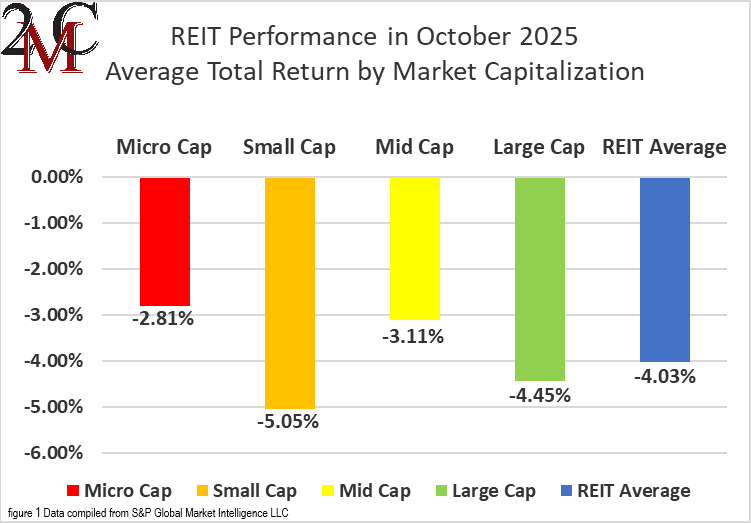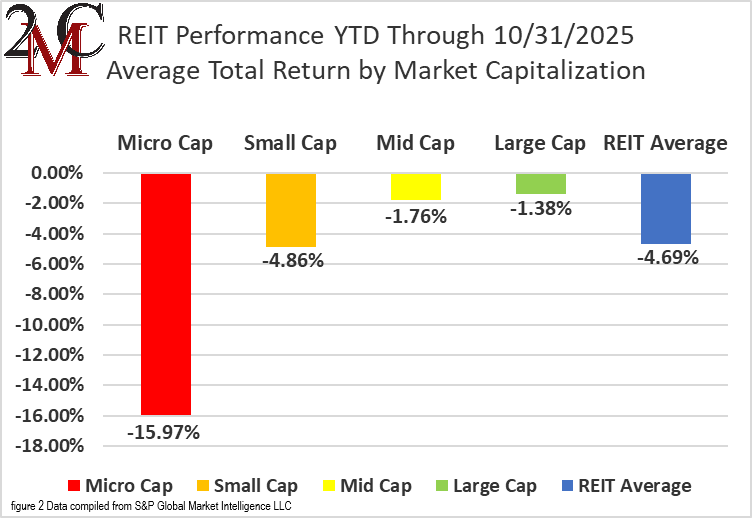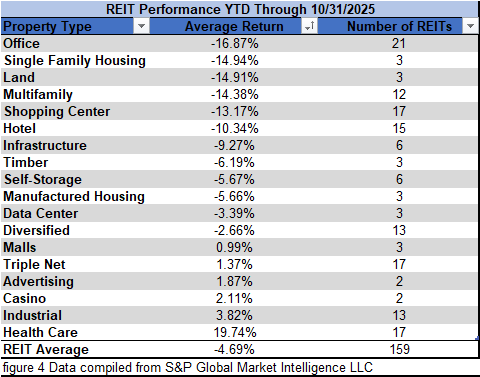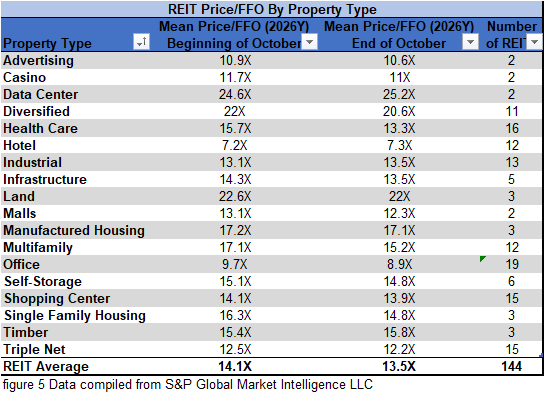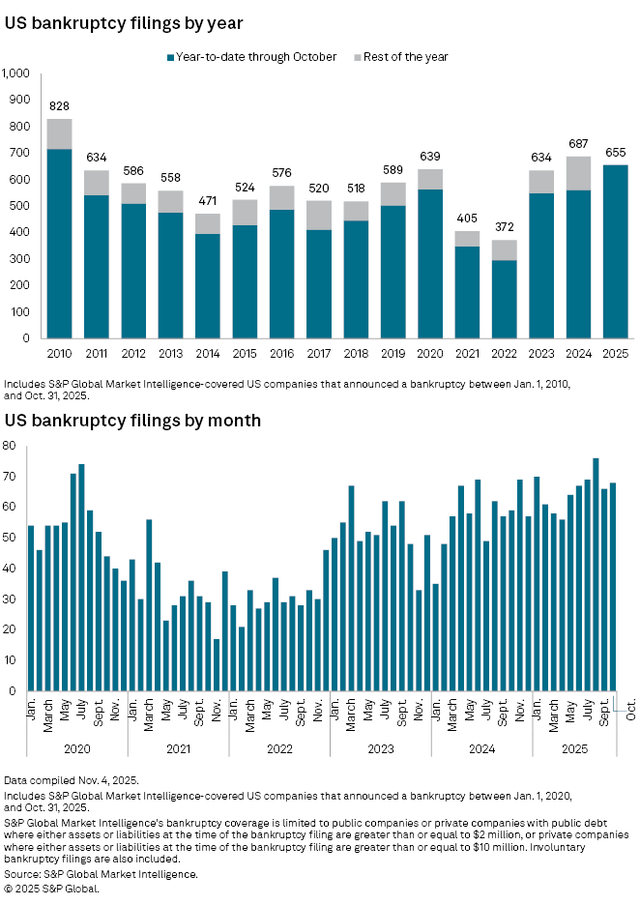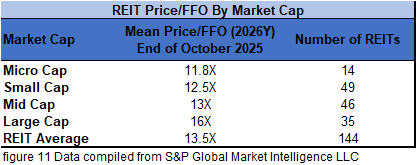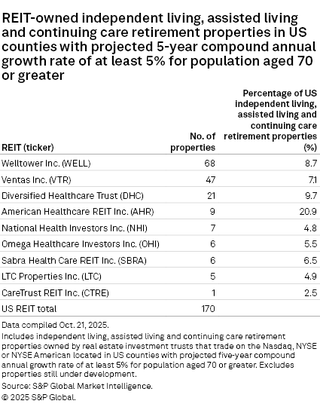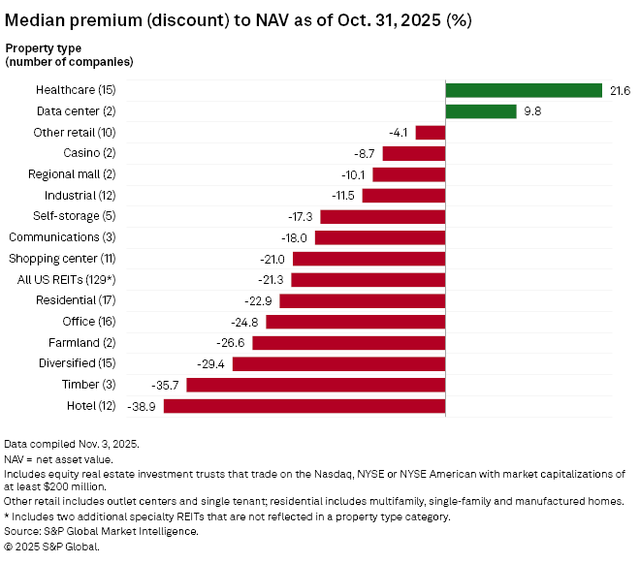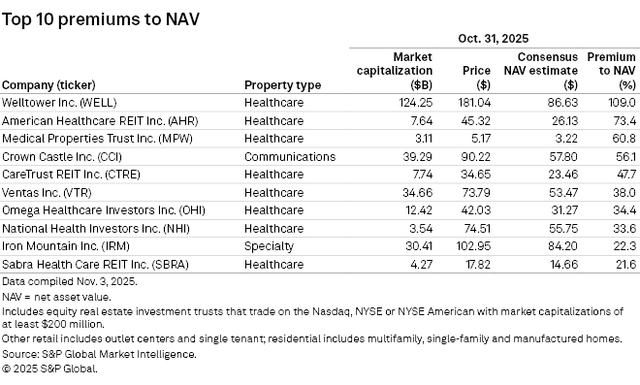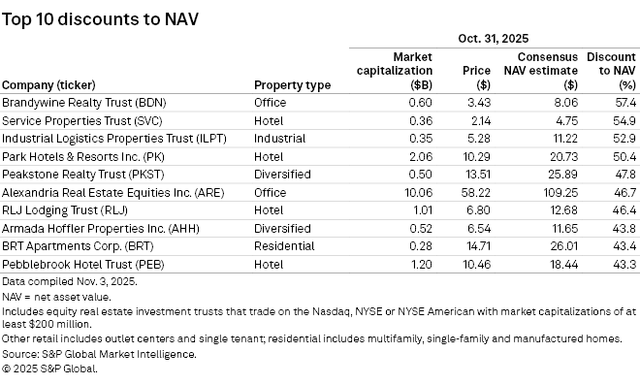The State of REITs: November 2025 Edition
- The REIT sector has seen back-to-back tough months as it saw a modest average negative total return in September (-0.73%) and fell deeper into the red in October (-4.03%).
- Small cap REITs (-5.05%) had the worst performance in October. Micro caps (-2.81%), mid caps (-3.11%) and large caps (-4.45%) were also in negative territory albeit to a smaller degree.
- Only 21.66% of REIT securities had a positive total return in October.
- 8% of REIT property types averaged negative returns in October. Hotels (+3.82%) and Data Centers (+2.53%) outpaced all other REIT property types while Office (-12.74%) and Infrastructure (-10.58%) struggled.
- The average REIT NAV discount widened again from -14.10% to -17.39% during October. The median NAV discount also widened from -17.40% to -21.38%.
REIT Performance
The REIT sector had a rough month in October with a -4.03% negative return. This brings the year-to-date return to -4.69% for the average REIT. The average REIT severely underperformed the broader market which saw strong gains from the NASDAQ (+4.7%), Dow Jones Industrial Average (+2.6%) and S&P 500 (+2.3%). The market cap weighted Vanguard Real Estate ETF (VNQ) saw a more modestly negative return than the average REIT in October (-2.45% vs. -4.03%) and has tremendously outperformed year-to-date (+2.98% vs. -4.69%). The spread between the 2026 FFO multiples of large cap REITs (16x) and small cap REITs (12.7x) widened in October as multiples contracted 0.4 turns for large caps and 1.2 turns for small caps. Investors currently need to pay an average of 26% more for each dollar of FFO from large cap REITs relative to small cap REITs. In this monthly publication, I will provide REIT data on numerous metrics to help readers identify which property types and individual securities currently offer the best opportunities to achieve their investment goals.
In October micro cap REITs (-2.81%) led the REIT sector with the smallest average declines. This was followed by mid caps (-3.11%), large caps (-4.45%) and a particularly weak performance by small caps (-5.05%). During the first ten months of 2025, large cap REITs have outperformed small caps by 348 basis points.
14 out of 18 Property Types Averaged Negative Returns in October
Only 22.22% of REIT property types averaged a positive total return in October. There was a 16.55% total return spread between the best and worst performing property types. Office (-12.74%) and Infrastructure (-10.58%) underperformed all other REIT property types in October. Hotels (+3.82%) and Data Centers (+2.53%) averaged the best total returns.
Office (-16.87%), Single Family Housing (-14.94%) and Land (-14.91%) have underperformed other property types over the first ten months of the year. Health Care (+19.74%) has dramatically outperformed year-to-date with average gains more than five times greater than that of any other REIT property type.
The REIT sector as a whole saw the average P/FFO (2026Y) decline from 14.1x to 13.5x during October. 22.2% of property types averaged multiple expansion and 77.8% averaged multiple contraction. Data Centers (25.3x), Land (22x), Diversified (20.9x) and Manufactured Housing (17.1x) currently trade at the highest average multiples among REIT property types. Hotels (7.3x) and Office (8.8x) are the only property types that average single digit FFO multiples.
Performance of Individual Securities
Sotherly Hotels (SOHO) (+165.00%) soared on October 27th on the announcement that Kemmons Wilson Hospitality Partners and Ascendant Capital Partners will acquire it. Shareholders will receive $2.25/share, which is an enormous 152.7% premium to SOHO’s closing price on the prior trading day. The transaction is expected to close in Q1 2026.
Office Properties Income Trust (OPI) (-88.76%) collapsed in October ahead of being delisted on October 6th and continued to free-fall on the OTC market under a new ticker (OPITQ). OPI filed for Chapter 11 bankruptcy on October 30th with a restructuring plan to reduce debt from about $2.4B down to about $1.3B. OPI’s awful -96.15% year-to-date return is the 2nd worst in the REIT sector behind Wheeler REIT’s -99.87%.
Only 21.66% of REITs had a positive total return in October. REITs have averaged a -4.69% year-to-date total return in 2025, more than 1100 basis points behind the +6.48% return for the REIT sector over the first ten months of 2024.

Dividend Yield
Dividend yield is an important component of a REIT’s total return. The particularly high dividend yields of the REIT sector are, for many investors, the primary reason for investment in this sector. As many REITs are currently trading at share prices well below their NAV, yields are currently quite high for many REITs within the sector. Although a particularly high yield for a REIT may sometimes reflect a disproportionately high risk, there exist opportunities in some cases to capitalize on dividend yields that are sufficiently attractive to justify the underlying risks of the investment. I have included below a table ranking equity REITs from highest dividend yield (as of 10/31/2025) to lowest dividend yield.

Although a REIT’s decision regarding whether to pay a quarterly dividend or a monthly dividend does not reflect on the quality of the company’s fundamentals or operations, a monthly dividend allows for smoother cash flow to the investor. Below is a list of equity REITs that pay monthly dividends, ranked from highest yield to lowest yield.
Valuation
REIT Premium/Discount to NAV by Property Type
Below is a downloadable data table, which ranks REITs within each property type from the largest discount to the largest premium to NAV. The consensus NAV used for this table is the average of analyst NAV estimates for each REIT. Both the NAV and the share price will change over time, so I will continue to include this table in upcoming issues of The State of REITs with updated consensus NAV estimates for each REIT for which such an estimate is available.
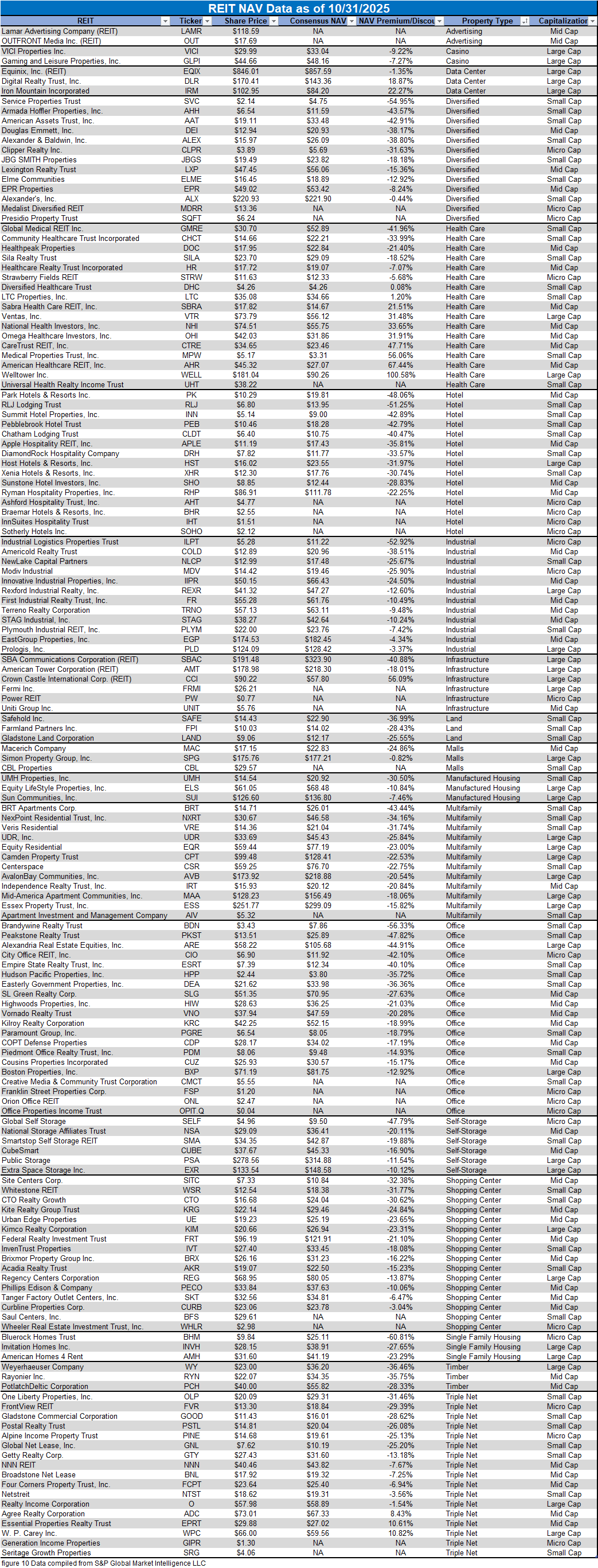
Takeaway
The large cap REIT premium (relative to small cap REITs) widened in October and investors are now paying on average about 26% more for each dollar of 2026 FFO/share to buy large cap REITs than small cap REITs (16x/12.5x – 1 = 26.0%). As can be seen in the table below, there is presently a strong positive correlation between market cap and FFO multiple.
The table below shows the average NAV premium/discount of REITs of each market cap bucket. This data, much like the data for price/FFO, shows a strong, positive correlation between market cap and Price/NAV. The average large cap (-7.89%) trades at a high single-digit discount to consensus NAV and mid cap REITs (-11.74%) trade at a low double-digit discount. Small cap REITs (-27.04%) trade a little under 3/4 of NAV while micro caps (-35.71%) trade for less than 2/3 of their respective NAVs.
Health Care REITs trade at Wide Premiums to NAV While Much of the REIT Sector Remains at a Discount
While the US population is already somewhat weighted toward older demographics, it is expected to trend even further in that direction over the next 5 years. The population of individuals under the age of 35 is expected to decline while the 70+ year old demographic is expected to rise significantly (+3.48%).
There are 127 counties that are projected for greater than 5% growth in this elderly population. Multiple Health Care REITs are well positioned to capitalize on this demographic shift as there are 170 REIT-owned senior housing properties in these counties (inclusive of independent living, assisted living and continuing care retirement properties).
Welltower (WELL) owns more than 1/3 of them and they account for 8.7% of WELL’s portfolio. The REITs which have the highest portion of their senior housing portfolio in these fast growing senior demographic counties are American Healthcare REIT (AHR) (20.9%) and Diversified Healthcare Trust (DHC) (9.7%). Other Health Care REITs with solid exposure to these markets are Ventas (VTR) (7.1%), Sabra Health Care REIT (SBRA) (6.5%) and Omega Healthcare Investors (OHI) (5.5%).
Thanks to strong fundamentals and favorable demographic trends, Health Care REITs trade at the widest NAV premium (+21.6%) of any REIT property type. Data Centers (+9.8%) are the only other property type trading at a premium. The most discounted property types are Hotels (-38.9%), Timber (-35.7%), Diversified (-29.4%) and Farmland (-26.6%).
Health Care REITs account for 8 of the 10 highest NAV premiums, led by WELL (+109%), American Healthcare REIT (AHR) (73.4%) and Medical Properties Trust (MPW) (+60.8%). The only non Health Care REITs in the top 10 are Crown Castle (CCI) (+56.1%) and Iron Mountain (IRM) (+22.3%).
Contrary to Health Care REIT valuations, most of the REIT sector trades at a discount to NAV. Brandywine Realty Trust (BDN) (-57.4%), Service Properties Trust (SVC) (-54.9%), Industrial Logistics Properties Trust (ILPT) (-52.9%) and Park Hotels & Resorts (PK) (-50.4%) all trade at less than half of consensus NAV. Even REITs with very high-quality assets like Alexandria Real Estate Equities (ARE) (-46.7%) can trade down to substantial NAV discounts when supply and demand fundamentals in their markets shift sharply in the wrong direction.
It is important to note that an NAV premium or discount does not inherently determine whether a REIT is a good investment opportunity. There are REITs trading at a premium for very good reason whose NAVs will continue to rise. Similarly, there are REITs trading at steep discounts due to poor balance sheets, bad management and a whole host of other issues. A thorough analysis of each REIT can help to determine if the magnitude of premium or discount to NAV is truly warranted or whether there is mispricing that creates opportunity for alpha.
Important Notes and Disclosure
All articles are published and provided as an information source for investors capable of making their own investment decisions. None of the information offered should be construed to be advice or a recommendation that any particular security, portfolio of securities, transaction, or investment strategy is suitable for any specific person. The information offered is impersonal and not tailored to the investment needs of any specific person.
We cannot determine whether the content of any article or recommendation is appropriate for any specific person. Readers should contact their financial professional to discuss the suitability of any of the strategies or holdings before implementation in their portfolio. Research and information are provided for informational purposes only and are not intended for trading purposes. NEVER make an investment decision based solely on the information provided in our articles.
We may hold, purchase, or sell positions in securities mentioned in our articles and will not disclose this information to subscribers, nor the time the positions in the securities were acquired. We may liquidate shares in profiled companies at any time without notice. We may also take positions inconsistent with the information and views expressed on our website.
We routinely own and trade the same securities purchased or sold for advisory clients of 2MCAC. This circumstance is communicated to our clients on an ongoing basis. As fiduciaries, we prioritize our clients’ interests above those of our corporate and personal accounts to avoid conflict and adverse selection in trading these commonly held interests.
Past performance does not guarantee future results. Investing in publicly held securities is speculative and involves risk, including the possible loss of principal. Historical returns should not be used as the primary basis for investment decisions. Although the statements of fact and data in this report have been obtained from sources believed to be reliable, 2MCAC does not guarantee their accuracy and assumes no liability or responsibility for any omissions/errors
Commentary may contain forward-looking statements that are by definition uncertain. Actual results may differ materially from our forecasts or estimations, and 2MCAC and its affiliates cannot be held liable for the use of and reliance upon the opinions, estimates, forecasts, and findings in this article.
Through October 2021, The State of REITs was published exclusively on Seeking Alpha by Simon Bowler, Sector Analyst at 2nd Market Capital Services Corporation (2MCSC). Editions subsequent to October 2021 will be published on this website in addition to other platforms that may include Seeking Alpha. 2MCSC was formed in 1989 and provides investment research and consulting services to the financial services industry and the financial media. 2MCSC does not provide investment advice. 2MCSC is a separate entity but related under common ownership to 2nd Market Capital Advisory (2MCAC), a Wisconsin registered investment advisor. Simon Bowler is an investment advisor representative of 2MCAC. Any positive comments made by others should not be construed as an endorsement of the author's abilities to act as an investment advisor.
S&P disclosure: S&P Global Market Intelligence LLC. Contains copyrighted material distributed under license from S&P.
Discover more from 2nd Market Capital Advisory Corp
Subscribe to get the latest posts sent to your email.
